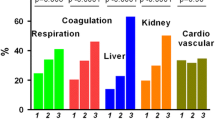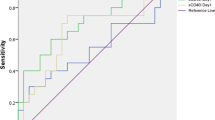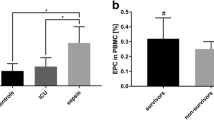Abstract
Purpose
CD163, a scavenger receptor for haptoglobin-hemoglobin complexes, is almost exclusively expressed by monocytes and macrophages and is shedded (as sCD163) by inflammatory stimuli. Thus, high serum levels of sCD163 predicted mortality in certain inflammatory diseases. We investigated baseline levels, time course of sCD163 levels and CD163 gene expression in relation to mortality and clinical complications in a large heterogeneous cohort of critically ill patients.
Methods
In this pre-planned secondary analysis of two randomized clinical studies, critically ill patients (n = 1657) were randomized to “conventional” (insulin administered only for blood glucose levels above 215 mg/dL) or “intensive” insulin therapy (glycemia maintained at 80–110 mg/dL) and compared with healthy controls (n = 112).
Results
Upon admission, critically ill patients had 1.6-fold higher sCD163 levels than controls (P < 0.0001). Long-stay patients (ICU stay >5 days), non-survivors and patients who developed liver dysfunction or kidney injury had higher baseline sCD163 levels. In multivariable analyses, elevated baseline sCD163 levels were independently associated with ICU mortality, liver dysfunction, and time to discharge from ICU and hospital. sCD163 further increased during ICU stay in patients who developed organ dysfunction and in non-survivors. Avoiding hyperglycemia with insulin slightly reduced circulating sCD163 levels. Hepatic CD163 gene expression in patients was higher than in controls (P = 0.002) and correlated positively with sCD163 levels (P = 0.345, P < 0.0001).
Conclusions
This study hallmarks the association of elevated sCD163 with organ dysfunction and adverse outcome of critical illness and may point to the liver as a potential source.




Similar content being viewed by others
Abbreviations
- ADAM17:
-
a disintegrin and metalloprotease domain 17
- ALT:
-
alanine aminotransferase
- AST:
-
aspartate aminotransferase
- AUC:
-
area under the curve
- BMI:
-
body mass index
- CI:
-
confidence interval
- CIT:
-
conventional insulin therapy
- CRP:
-
C-reactive protein
- HPRT:
-
hypoxanthine-guanine phosphoribosyltransferase
- ICU:
-
intensive care unit
- IIT:
-
intensive insulin therapy
- IQR:
-
interquartile range
- LDH:
-
lactate dehydrogenase
- LPS:
-
lipopolysaccharide
- PT:
-
prothrombin time
- ROC:
-
receiver operating characteristic curve
- SIRS:
-
systemic inflammatory response syndrome
- SD:
-
standard deviation
- TACE:
-
TNF-α converting enzyme
- TLR:
-
Toll-like receptor
- TNF-α:
-
tumor-necrosis factor α
References
Maniecki MB, Møller HJ, Moestrup SK, Møller BK. CD163 positive subsets of blood dendritic cells: the scavenging macrophage receptors CD163 and CD91 are coexpressed on human dendritic cells and monocytes. Immunobiology. 2006;211:407–17.
Ritter M, Buechler C, Langmann T, Orso E, Klucken J, Schmitz G. Regulation of scavenger receptor CD163 expression in human monocytes and macrophages by pro- and anti-inflammatory stimuli. J Leukoc Biol. 2000;67:97–103.
Fabriek B, Dijkstra C, Van den Berg T. The macrophage scavenger receptor CD163. Immunobiology. 2005;210:153–60.
Schaer DJ, Schaer CA, Schoedon G, Imhof A, Kurrer MO. Hemophagocytic macrophages constitute a major compartment of heme oxygenase expression in sepsis. Eur J Haematol. 2006;77:432–6.
Sulahian TH, Pioli PA, Wardwell K, Guyre PM. Cross-linking of FCgammaR triggers shedding of the hemoglobin-haptoglobin scavenger receptor CD163. J Leukoc Biol. 2004;76:271–7.
Timmermann M, Hogger P. Oxidative stress and 8-iso-prostaglandin F(2alpha) induce ectodomain shedding of CD163 and release of tumor necrosis factor-alpha from human monocytes. Free Radic Biol Med. 2005;39:98–107.
Van Gorp H, Delputte P, Nauwynck H. Scavenger receptor CD163, a jack-of-all-trades and potential target for cell-directed therapy. Mol Immunol. 2010;47:1650–60.
Møller HJ, Nielsen MJ, Maniecki MB, Madsen M, Moestrup SK. Soluble macrophage-derived CD163: a homogenous ectodomain protein with dissociable haptoglobin-hemoglobin binding. Immunobiology. 2010;215:406–12.
Schaer DJ, Schleiffenbaum B, Kurrer M, Imhof A, Bächli E, Fehr J, Møller HJ, Moestrup SK, Schaffner A. Soluble hemoglobin-haptoglobin scavenger receptor CD163 as a lineage specific marker in the reactive hemophagocytic syndrome. Eur J Haematol. 2005;74:6–10.
Hiraoka A, Horiike N, Akbar SM, Michitaka K, Matsuyama T, Onji M. Soluble CD163 in patients with liver diseases: very high levels of soluble CD163 in patients with fulminant hepatic failure. J Gastroenterol. 2005;40:52–6.
Holland-Fischer P, Grønbæk H, Sandahl TD, Moestrup SK, Riggio O, Ridola L, Aagaard NK, Møller HJ, Vilstrup H. Kupffer cells are activated in cirrhotic portal hypertension and not normalised by TIPS. Gut. 2011;60:1389–93.
Møller HJ, Peterslund NA, Graversen JH, Moestrup SK. Identification of the hemoglobin scavenger receptor/CD163 as a natural soluble protein in plasma. Blood. 2002;99:378–80.
Weiss M, Schneider EM. Soluble CD163: an age-dependent, anti-inflammatory biomarker predicting outcome in sepsis. Crit Care Med. 2006;34:2682–83.
Møller HJ, Moestrup SK, Weis N, Wejse C, Nielsen H, Pedersen SS, Attermann J, Nexø E, Kronborg G. Macrophage serum markers in pneumococcal bacteremia: prediction of survival by soluble CD163. Crit Care Med. 2006;34:2561–6.
Bleesing J, Prada A, Siegel DM, Villanueva J, Olson J, Ilowite NT, Brunner HI, Griffin T, Graham TB, Sherry DD, Passo MH, Ramanan AV, Filipovich A, Grom AA. The diagnostic significance of soluble CD163 and soluble interleukin-2 receptor alpha-chain in macrophage activation syndrome and untreated new-onset juvenile idiopathic arthritis. Arthritis Rheum. 2007;56:3877–8.
Baeten D, Demetter P, Cuvelier CA, Kruithof E, Van Damme N, De Vos M, Veys EM, De Keyser F. Macrophages expressing the scavenger receptor CD163: a link between immune alterations of the gut and synovial inflammation in spondyloarthropathy. J Pathol. 2002;196:343–50.
Aristoteli LP, Møller HJ, Bailey B, Moestrup SK, Kritharides L. The monocytic lineage specific soluble CD163 is a plasma marker of coronary atherosclerosis. Atherosclerosis. 2006;184:342–7.
Fabriek BO, Møller HJ, Vloet RP, van Winsen LM, Hanemaaijer R, Teunissen CE, Uitdehaag BM, van den Berg TK, Dijkstra CD. Proteolytic shedding of the macrophage scavenger receptor CD163 in multiple sclerosis. J Neuroimmunol. 2007;187:179–86.
Asleh R, Marsh S, Shilkrut M, Binah O, Guetta J, Lejbkowicz F, Enav B, Shehadeh N, Kanter Y, Lache O, Cohen O, Levy NS, Levy AP. Genetically determined heterogeneity in hemoglobin scavenging and susceptibility to diabetic cardiovascular disease. Circ Res. 2003;92:1193–200.
Philippidis P, Athanasiou T, Nadra I, Ashrafian H, Haskard DO, Landis RC, Taylor KM. Anti-inflammatory haemoglobin scavenging monocytes are induced following coronary artery bypass surgery. Eur J Cardiothorac surg. 2010;37:1360–6.
Møller HJ. Soluble CD163. Scand Clin J Lab Invest. 2012;72:1–13.
Van den Berghe G, Wouters P, Weekers F, Verwaest C, Bruyninckx F, Schetz M, Vlasselaers D, Ferdinande P, Lauwers P, Bouillon R. Intensive insulin therapy in critically ill patients. N Engl J Med. 2001;345:1359–67.
Van den Berghe G, Wilmer A, Hermans G, Meersseman W, Wouters PJ, Milants I, Van Wijngaerden E, Bobbaers H, Bouillon R. Intensive insulin therapy in the medical ICU. N Engl J Med. 2006;354:449–61.
Hansen TK, Thiel S, Wouters PJ, Christiansen JS, Van den Berghe G. Intensive insulin therapy exerts antiinflammatory effects in critically ill patients and counteracts the adverse effect of low mannose-binding lectin levels. J Clin Endocrinol Metab. 2003;88:1082–8.
Hiraoka A, Horiike N, Akbar SM, Michitaka K, Matsuyama T, Onji M. Expression of CD163 in the liver of patients with viral hepatitis. Pathol Res Pract. 2005;201:379–84.
Møller H, Hald K, Moestrup S. Characterization of an enzyme-linked immunosorbent assay for soluble CD163. Scand J Clin Lab Invest. 2002;62:293–9.
Møller HJ. Biological variation of soluble CD163. Scand J Clin Lab Invest. 2003;63:15–21.
Casaer MP, Mesotten D, Hermans G, Wouters PJ, Schetz M, Meyfroidt G, Van Cromphaut S, Ingels C, Meersseman P, Muller J, Vlasselaers D, Debaveye Y, Desmet L, Dubois J, Van Assche A, Vanderheyden S, Wilmer A, Van den Berghe G. Early versus late parenteral nutrition in critically ill adults. N Engl J Med. 2011;365:506–17.
Pepys M, Hirschfield G. C-reactive protein: a critical update. J Clin Invest. 2003;111:1805–12.
Lobo SM, Lobo FR, Bota DP, Lopes-Ferreira F, Soliman HM, Mélot C, Vincent JL. C-reactive protein levels correlate with mortality and organ failure in critically ill patients. Chest. 2003;123:2043–9.
Wang F, Pan W, Pan S, Wang S, Ge Q, Ge J. Usefulness of N-terminal pro-brain natriuretic peptide and C-reactive protein to predict ICU mortality in unselected medical ICU patients: a prospective, observational study. Crit Care. 2011;15(1):R42.
DeLong ER, DeLong DM, Clarke-Pearson DL. Comparing the areas under two or more correlated receiver operating characteristic curves: a nonparametric approach. Biometrics. 1988;44:837–45.
Mesotten D, Wauters J, Van den Berghe G, Wouters PJ, Milants I, Wilmer A. The effect of strict blood glucose control on bilirary sludge and cholestasis in critically ill patients. J Clin Endocrinol Metab. 2009;94:2345–52.
Gaïni S, Pedersen SS, Koldkaer OG, Pedersen C, Moestrup SK, Møller HJ. New immunological serum markers in bacteraemia: anti-inflammatory soluble CD163, but not proinflammatory high mobility group-box 1 protein, is related to prognosis. Clin Exp Immunol. 2008;151:423–31.
Møller HJ, Grønbaek H, Schiødt FV, Holland-Fischer P, Schilsky M, Munoz S, Hassanein T, Lee WM. U.S Acute Liver Failure Study Group. Soluble CD163 from activated macrophages predicts mortality in acute liver failure. J Hepatol. 2007;47:671–6.
Possamai LA, Antoniades CG, Anstee QM, Quaglia A, Vergani D, Thursz M, Wendon J. Role of monocytes and macrophages in experimental and human acute liver failure. World J Gastroenterol. 2010;16:1811–9.
Rolando N, Wade J, Davalos M, Wendon J, Philpott-Howard J, Williams R. The systemic inflammatory response syndrome in acute liver failure. Hepatology. 2000;32:734–9.
Etzerodt A, Maniecki MB, Møller K, Møller HJ, Moestrup SK. Tumor necrosis factor α-converting enzyme (TACE/ADAM17) mediates ectodomain shedding of the scavenger receptor CD163. J Leukoc Biol. 2010;88:1201–5.
Hintz KA, Rassias AJ, Wardwell K, Moss ML, Morganelli PM, Pioli PA, Givan AL, Wallace PK, Yeager MP, Guyre PM. Endotoxin induces rapid metalloproteinase-mediated shedding followed by up-regulation of the monocyte hemoglobin scavenger receptor CD163. J Leukoc Biol. 2002;72:711–7.
Rother RP, Bell L, Hillmen P, Gladwin MT. The clinical sequelae of intravascular hemolysis and extracellular plasma hemoglobin: a novel mechanism of human disease. JAMA. 2005;293:1653–62.
Otterbein LE, Soares MP, Yamashita K, Bach FH. Heme oxygenase-1: unleashing the protective properties of heme. Trends Immunol. 2003;24:449–55.
Strauss R, Neureiter D, Westenburger B, Wehler M, Kirchner T, Hahn EG. Multifactorial risk analysis of bone marrow histiocytic hyperplasia with hemophagocytosis in critically ill medical patients - a postmortem clinicopathologic analysis. Crit Care Med. 2004;32:1316–21.
Knudsen TB, Larsen K, Kristiansen TB, Møller HJ, Tvede M, Eugen-Olsen J, Kronborg G. Diagnostic value of soluble CD163 serum levels in patients suspected of meningitis: comparison with CRP and procalcitonin. Scand J Infect Dis. 2007;39:542–53.
Gaïni S, Koldkjaer O, Pedersen SS, Pedersen C, Moestrup SK, Møller HJ. Soluble haemoglobin scavenger receptor (sCD163) in patients with suspected community-acquired infections. APMIS. 2006;114:103–11.
Himmelfarb J. Linking oxidative stress and inflammation in kidney disease: which is the chicken and which is the egg? Sem Dial. 2004;17:449–54.
Doi K, Leelahavanichkul A, Yuen PS, Star RA. Animal models of sepsis and sepsis-induced kidney injury. J Clin Invest. 2009;119:2868–78.
Faubel S. Acute kidney injury and multiple organ dysfunction syndrome. Minerva Urol Nefrol. 2009;61:171–88.
Axelsson J, Møller HJ, Witasp A, Qureshi AR, Carrero JJ, Heimbürger O, Bárány P, Alvestrand A, Lindholm B, Moestrup SK, Stenvinkel P. Changes in fat mass correlate with changes in soluble sCD163, a marker of mature macrophages, in patients with CKD. Am J Kidney Dis. 2006;48:916–25.
Su L, Feng L, Jiang Z, Li M, Xiao K, Yan P, Jia Y, Feng D, Liu C, Xie L. Diagnostic value of urine sCD163 levels for sepsis and relevant acute kidney injury: a prospective study. BMC Nephrol. 2012;13:123.
Losser M-R, Damoisel C, Payen D. Bench-to-bedside review: glucose and stress conditions in the intensive care unit. Crit Care. 2010;14:231–42.
Brownlee M. Biochemistry and molecular cell biology of diabetic complications. Nature. 2001;414:813–20.
Vlasselaers D, Milants I, Desmet L, Wouters PJ, Vanhorebeek I, van den Heuvel I, Mesotten D, Casaer MP, Meyfroidt G, Ingels C, Muller J, Van Cromphaut S, Schetz M, Van den Berghe G. Intensive insulin therapy for patients in paediatric intensive care: a prospective, randomised controlled study. Lancet. 2009;373:547–56.
Acknowledgements
We thank Kirsten Bank Petersen for excellent technical assistance.
CI received a Doctoral Fellowship of the Clinical Research Fund of the University Hospitals Leuven. GVdB by the University of Leuven, receives long-term structural research financing via the Methusalem program, funded by the Flemish Government.
Competing Interests
HM and Aarhus University have received royalties from IQ-products, the Netherlands.
The other authors declare that they have no competing interest.
Author information
Authors and Affiliations
Corresponding author
Rights and permissions
About this article
Cite this article
Ingels, C., Møller, H.J., Hansen, T.K. et al. Circulating Levels of the Shed Scavenger Receptor sCD163 and Association with Outcome of Critically Ill Patients. J Clin Immunol 33, 619–629 (2013). https://doi.org/10.1007/s10875-012-9830-9
Received:
Accepted:
Published:
Issue Date:
DOI: https://doi.org/10.1007/s10875-012-9830-9




